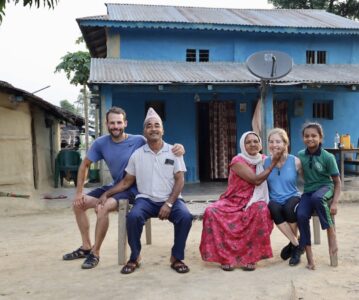The short morning drive to the border reconciles at least me somewhat with India. There is hardly any traffic on the small side road, a few jingling horse-drawn carts cross our path and the morning sun conjures a warm light over the colorful little houses with their gardens. Mango and lychee trees, papaya and banana bushes grow along the roadside. Cows and goats are taken out to graze and newspaper-reading men sit in front of the tea rooms.
The access road to the border gets narrower the longer it goes on, and finally offers only space for two-wheeled traffic and pedestrians. We cross a long bridge over a dam and find ourselves in the extremely peaceful border area. Here, too, international cattle graze easily and we find the small border offices only thanks to the friendly waving officials. After some paperwork we are stamped out of India and our passports are looked through attentively by various soldiers; probably more out of interest than necessity.
Also on the Nepalese side it is leisurely and relaxed. In the meantime a small fuse fire breaks out, but fortunately it can be extinguished and the computers do not crash. In the meantime, the Nepalese authorities have also switched to IT and we have to email our completed corona and entry documents to the officials on the spot. When we finally got our visa stickers, it is already 11 o’clock and accordingly hot. For the sake of our ailing health, we treat ourselves to another room and plan an early start for the next day.
“686 km to Kathmandu”, a road sign announces. That’s really not far now! Finally in better shape, we pedal early the next day and find ourselves on the most relaxed main road we can imagine. Hardly any traffic, but all the more bicycles meet us here. In the terrain one drives and woman bicycle!
We leisurely cruise through the lush landscape. The houses are partly still very traditionally built from clay, wood and palm leaves and remind of scenes from the jungle book of Kippling. Again and again the road leads for many kilometers through wild forest with wild animal warnings and termite mounds at the roadside. The first national park is not long in coming. Bridges lead over wide river courses in which numerous water buffalos bathe. Today we spend our heat-induced long lunch break under a bridge. The river water is low and warm, but still good for occasional cooling. We don’t stay alone for long and get to know some children and teenagers from the nearby settlements. While the younger ones are fishing small fish out of the water with self-made fishing rods, the older ones are heavily occupied with “Tik Tok”. This Chinese self-promotion platform seems to be THE app here. We share our snacks, lots of laughter and spend some peaceful hours in the shade.
Today we finally want to camp again! Only a place close to people comes into question; the high grass and the jungle are not very inviting. So we look for a house with friendly inhabitants and some space around and soon we find it. My Nepalese is enough to explain us and soon we pitch our tent next to the open cow shed. In the house lives an elderly couple with their granddaughter. The parents work in a town further away and only drop by every few weeks.
In addition, various children from the neighborhood romp around under the mango tree in the yard and we chat in English and Nepali with neighbor women and the older girls. When we unpack our kitchen utensils, I soon feel like in a cooking show. People follow with interest what and how we cook. Our meal is simple: some lentils, rice and pumpkin, all in just one pot are our dinner. Finally, we both like to eat our usual amount again!
We feel healthy, comfortable and relaxed again and despite the temperature and the mosquitoes, we feel that we have found our way back into our traveling rhythm.
The next day brings long forest drives, many nice encounters on the roadside and a wonderful lunch break: We reach the mighty Karnali River. An impressive suspension bridge crosses the water masses and forms the entrance to the Bardia National Park.
We settle in at the shady riverbank with the hammock and jump every now and then into the wonderfully cold stream. The boys and girls of all ages from the settlement of Chisapani (“cold water”) are absolute professionals and spend the whole afternoon in and around the cold water. Soon we are surrounded by numerous children. We share our snacks with the “pack” and watch in awe as one of the leaders makes the rounds, fairly and squarely handing out pieces of fruit and Dahl chips to all the kids. Despite the chatter, we doze a bit, cool off in the river every now and then, watch the children’s games and let the afternoon pass. We want to spend the night somewhere here, but it is a little less easy to find a place than we had hoped. Towards evening we treat ourselves to a delicious Dahlbath (national dish of Nepal; rice, dahl soup and various vegetable curries) including fresh fish in one of the numerous open kitchens in front of the bridge and watch a little worried as suddenly very dark clouds appear. Thanks to our language skills, the friendly landlord offers us to spend the night on the roof of his house. When we try to set up our tent on the covered flat roof a little later, our attempts are made impossible by wild gusts of wind. Fortunately, there is an empty room that we are allowed to use in the rain and we have no choice but to accept the offer. The storm is fierce and continues. The temperatures cool the air wonderfully, but camping is out of the question today.
Translated with www.DeepL.com/Translator (free version)


